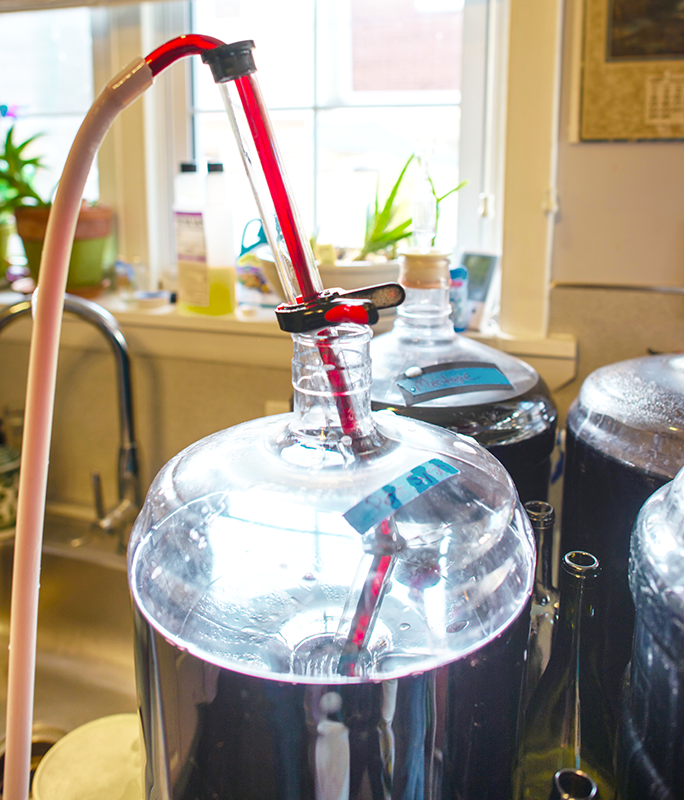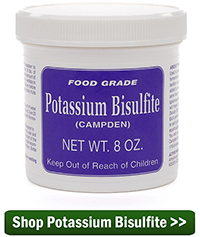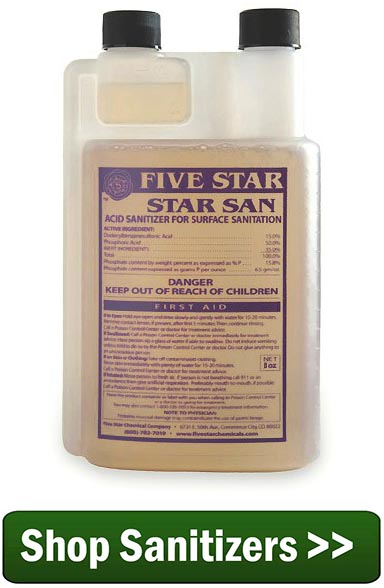 Bill has made a few small batches of home wine, and all went well. This year we did a strawberry-rhubarb and on the third racking in a 5 gal jug, it developed a thin white scum over the center of top. We could get past the film to re-rack, but Bill is concerned it is ruined…is it? Has this white scum on top of his homemade wine ruined it?
Bill has made a few small batches of home wine, and all went well. This year we did a strawberry-rhubarb and on the third racking in a 5 gal jug, it developed a thin white scum over the center of top. We could get past the film to re-rack, but Bill is concerned it is ruined…is it? Has this white scum on top of his homemade wine ruined it?
Name: Gidget M.
State: PA
—–
Hello Gidget,
What this sounds like is something called flowers or flowers of wine. It starts off as patches of white scum or a white film. If left uncheck it can grow to cover the entire surface of the wine. It is actually a small bacterial growth on the wines surface.
Just because the wine has this white scum or film on top does not mean it is ruined by any means, but some actions should be taken to see that it does not get any worse.
Just as you have suggested, you need to rack the wine away from the bacterial growth. Draw the wine from the center of the fermenter, passed the white film on top, but not from the vary bottom, either. Once you get it racked, dose it with either Campden tablets, potassium metabisulfite or sodium metabisulfite. Any of these will easily destroy any bacteria cells that may still be in the wine.
What allowed the white scum on top of your homemade wine to occur in the first place was having too much head-space in with the fermenter with the wine. This is okay during a fermentation, when CO2 gas is coming off the liquid, but after the fermentation the head-space needs to be eliminated.
It is the air in contact with the wine that can promote a bacterial growth such as the one you are experiencing. In the future, after the fermentation has completed, I would suggest that you keep whatever fermenter the wine is in topped-up. There are many ways you can top-up a fermenter. You can read more about this in the follow article: Topping Up Your Homemade Wines.
I would also recommend that you automatically add one of the three forms of sulfite mention earlier after the fermentation. This will dramatically help keep your homemade wines from getting this white scum or film.
 Going back to your strawberry/rhubarb wine, it is fine. Based on your description, it does not sound like the white scum or film advanced enough to affect the wine’s flavor in any significant way. If sulfites are added to the wine, flavor and aroma would be the only concern to take into consideration. Rack the wine, and add sulfites.
Going back to your strawberry/rhubarb wine, it is fine. Based on your description, it does not sound like the white scum or film advanced enough to affect the wine’s flavor in any significant way. If sulfites are added to the wine, flavor and aroma would be the only concern to take into consideration. Rack the wine, and add sulfites.
Once the wine has cleared and is ready to bottle, sample it and see what you think. The wine will be perfectly safe to drink. You are only noting the flavor and aroma.
Happy Winemaking,
Ed Kraus
—–
Ed Kraus is a 3rd generation home brewer/winemaker and has been an owner of E. C. Kraus since 1999. He has been helping individuals make better wine and beer for over 25 years.

I have a question: what might be the cause of a wine that stains the bottles. I made a wine that smelled and tasted bad and stained the bottles purple where the wine sat in them. Could it be the way I tried to sanitize my bottles?
Mack
I have had that too. The stain disolves out with a strong alkali. TSP works good. Its cause i traced back to high ph. It caused some kind of an unstable situation. Im not a chemist, but getting the ph >3.7 made the problem go away.
Any film or stain caused by the wine making process, can be etched off using distilled vinegar. You can make a vinegar similar to Amway LOC by, making tomato wine and cold distilling it. I have used both and made the TWA. Always rinse until you can not smell the cleaner and it will not effect the new wine.
Mack, I honestly don’t have an answer for you. What I do know is that if the glass is truly stained it was a strong acid that did it. Anyone else have any comments?
I have my bottles stained when I make blackberry wine. I find the pink powdered soap works for removing it.
What if this occurs / you notice it right before you’re supposed to bottle?
Steve, the steps are still pretty much the same. As long as it is only on the surface of the wine, rack it away from growth, treat it with sulfites and bottle it immediately.
Ed,
I am having the same trouble with a batch of cherry wine I am making in my conical fermenter. The head space in this kind of fermenter cannot be eliminated. How so I prevent the bacteria from starting in wine I make in this fermenter? Thanks, for the help. Joe
What if my strawberry wine has a wonderful flavor and tasty at the very beginning but once you swallow it there is a strong bitter aftertaste that seems to stay with you ? Any idea s ?? Thanks
After racking wine I hv a scum floating on top of red wine and scum floating on bottom of white wine I use bottles w screw on lids the wine tasted good b4 bottling worried it’s not gonna later
Does anyone know why I might be having this white powder on the top of the bottle. Over the lead label covering the cork?
Peter? My guess is you got some of the wine on top of the bottle and lead label when corking and labeling the bottles. Leaving a film of wine juice on the caps that you couldn’t see. I assume it was a sweet wine that still had enough sugar content in it, and so when you put the bottles away the film of wine dried out in the open air leaving a white power look. That my guess, anyway.
Ed – we have a batch of apple wine which we started fermenting 4 days ago which is developing a white bacterial layer. Do you recommend the same treatment (i.e., Campden tablets, potassium metabisulphite or sodium metabisulphite) if the wine is going to be distilled into spirits? Thanks for your thoughts.
Melanie, no, it will not effect whatever you plan to do with the wine after completion.
Ed, do you mean “no, don’t use the same treatment beause it will have no effect,” or “no, it’s safe to use the same treatment because it will have no bad effect”? Thanks, this is a great winemaking page!
Far, let me clarify what I was trying to say. You do want to treat the infection with sulfites. What we are saying is that treating the infection with campden tablets will have no effect on what they plan to do with the wine after completion.
With only 4 days of fermenting, I trust you mean ‘kill the infection and THEN restart the fermentation with new yeast’.
I heard distilling wine was risky for producing Methanol, which is toxic?
Right don’t try it you will go blind!! 😉
I have a question. I gave a bottle of Elderberry to my grandson for Christmas. He was going to enjoy it for dinner today but says it tastes very tart and soured. He says it smells like rotten apples in a plastic bag (very descriptive !) He says it is also thicker than all my other wines have been. I made this in August, racked it twice, back sweetened it added camden tablet and bottled it on Oct.1. I noticed while making this batch all my equipment had a sticky residue that I could hardly remove from everything. I am 82 and just starting to make wine and loving it. Please tell me I am not going to make him sick !!
I don’t know why the wine is sticky and sour, but I do know that when I made elderberry with fresh berries it left a horrible gunk on everything. I think i got it off with olive oil…..(?) Next time I’m going to try dried berries. I hear it’s a common problem. I was also concerned about the small amount of cyanide in the fresh berries, so I cooked my must a second time to make sure I neutralized it sufficiently, thus remessing up my pot. My wine was also somewhat sour, but I kind of liked it. In a medicinal sort of way, of course………
I have this problem with a Chilean red that I made this spring. The wine was filled in the carboy to just below the bung, but I still got the white film anyway. Initially, when I racked the wine to the 6 gal. carboy I added 1/2 tsp. of Pot. Met. Is it okay to add more Pot. Met., or am I at my limit? Thanks!
How much potassium metabisulfate should you use for 1 gallon of red wine that has a wine film on top?
My blueberry wine has stuff on top floating that looks like cottage cheese this wine was racked once but I’m worried that it might not be good
Carol, as long as the growth is not only on top, you can treat it with sulfites. Just transfer the wine away from the growth and treat it with the sulfites.
Late to the thread but I was gifted an unopened pear brandy from 2006. It has white spots/clumps (they almost look like bunches of tapioca or cell masses) floating throughout the liquid (sits towards the bottom). I have not opened the bottle and cannot see under the lead seal whether there’s air between the cork and liquid. What the heck is it? Can I filter it out and drink away or has it ruined the brandy? Thanks so much for your time!
I made a sugar wine its my first time and i have a while film in the bottom is it the same thing?